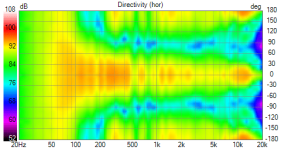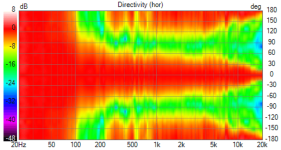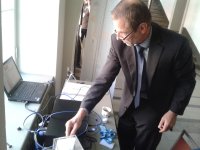I used to have magnepans in my system and toyed for years with various open baffle subs. I had at one time thought about building my end game system around open baffle speakers and a hybrid open baffle sub based on an idea I hadn't run across anywhere before.
But plans changed some time ago, and for whatever reason I realized recently that I never did anything with that idea or shared it so others could experiment. So, here we go...
1. Construct a sealed dual opposed sub with matched front/rear drivers, a little atypical in dimensions for a sealed sub in that wide and tall but shallow front to back (like an OB baffle) is desired. Size net internal volume appropriate for the two subs as a sealed design. Optionally, probably ideally, the rear driver is mounted inverted so that both cones face forward, and box can be much shallower as the magnets are not abutting and the cone for rear driver gives additional clearance for front driver.
2. Each sub is driven by indepent amplification channel.
3. Place an all pass filter before amplification for one driver (ideally, adjustable), such that above filter Fc the two drivers are in phase electrically (and cones moving same direction if rear is mounted inverted as above), and below Fc the subs are 180 deg out of phase electrically (and moving in opposite directions). If rear driver isn't inverted physically, it's polarity should be.
The result should be, I think, an essentially open baffle sub >> Fc where drivers are in phase, and an essentially sealed sub <<Fc where drivers are out of phase, passing through a transition region around Fc that I think will be some varying cardioid shape.
Negatives are the additional sub and amp channel needed which will add no output in the OB range over a single sub and amp, and maybe suboptimal baffle shape due to some required depth based on driver dimensions. Benefits? For starters, additional output in sealed range from the doubled sub and more importantly from sealed vs dipole behavior below panel dipole frequency. Also, the transition region should be a smoothly varying cardioid instead of whatever superposition you get from pairing an OB sub with a sealed or ported sub handling lowest frequencies not co-located. And, making an all pass filter adjustable is easy, so it should be pretty easy to fine tune the end result around enclosure design, drivers chosen, room size, and most importantly measured in room response.
Thoughts? Was this sold by someone for several years but ceased because no one wanted it!? 😂
But plans changed some time ago, and for whatever reason I realized recently that I never did anything with that idea or shared it so others could experiment. So, here we go...
1. Construct a sealed dual opposed sub with matched front/rear drivers, a little atypical in dimensions for a sealed sub in that wide and tall but shallow front to back (like an OB baffle) is desired. Size net internal volume appropriate for the two subs as a sealed design. Optionally, probably ideally, the rear driver is mounted inverted so that both cones face forward, and box can be much shallower as the magnets are not abutting and the cone for rear driver gives additional clearance for front driver.
2. Each sub is driven by indepent amplification channel.
3. Place an all pass filter before amplification for one driver (ideally, adjustable), such that above filter Fc the two drivers are in phase electrically (and cones moving same direction if rear is mounted inverted as above), and below Fc the subs are 180 deg out of phase electrically (and moving in opposite directions). If rear driver isn't inverted physically, it's polarity should be.
The result should be, I think, an essentially open baffle sub >> Fc where drivers are in phase, and an essentially sealed sub <<Fc where drivers are out of phase, passing through a transition region around Fc that I think will be some varying cardioid shape.
Negatives are the additional sub and amp channel needed which will add no output in the OB range over a single sub and amp, and maybe suboptimal baffle shape due to some required depth based on driver dimensions. Benefits? For starters, additional output in sealed range from the doubled sub and more importantly from sealed vs dipole behavior below panel dipole frequency. Also, the transition region should be a smoothly varying cardioid instead of whatever superposition you get from pairing an OB sub with a sealed or ported sub handling lowest frequencies not co-located. And, making an all pass filter adjustable is easy, so it should be pretty easy to fine tune the end result around enclosure design, drivers chosen, room size, and most importantly measured in room response.
Thoughts? Was this sold by someone for several years but ceased because no one wanted it!? 😂
Reminds me of this design here: https://www.diyaudio.com/community/threads/open-baffle-bass-reflex-hybrid.393837/
Yes this idea will work. I did a lot of modeling on this concept about 7-8 years ago. Use the AP filter on the front driver. This will have delay at DC and with the right parameters you can get it to be in phase, but one cycle behind, the rear driver. With increasing frequency the delay from the AP falls and the phase angle rotates back around towards zero at HF. What happens is that the sum of the front and rear go through cardioid to dipole.
There are two problems:
The delay from the AP levels off at LF but the delay needed to maintain the in-phase relationship with the rear driver keeps increasing. This means that at some LF the drivers again become out of phase. With the correct design this is below 20Hz, so not that important. But you will not get the DC room pressurization of a single monopole.
At high frequency the distance between the drivers influences the dipole behavior. At some frequency you pass the dipole peak and the on axis response falls down into the first null, but the off axis response keeps increasing for a bit. It's the usual pattern for a dipole. The farther apart the two drivers the lower in frequency this will happen. If you will be using this only as a subwoofer, then this is not really a concern. But if you want to cross over higher, like 200Hz or higher, then this is something to consider.
In the end you can just use a single monopole subwoofer with your dipole panel. Much easier to design and it will integrate just fine as long as the crossover point is 80 Hz or lower.
There are two problems:
The delay from the AP levels off at LF but the delay needed to maintain the in-phase relationship with the rear driver keeps increasing. This means that at some LF the drivers again become out of phase. With the correct design this is below 20Hz, so not that important. But you will not get the DC room pressurization of a single monopole.
At high frequency the distance between the drivers influences the dipole behavior. At some frequency you pass the dipole peak and the on axis response falls down into the first null, but the off axis response keeps increasing for a bit. It's the usual pattern for a dipole. The farther apart the two drivers the lower in frequency this will happen. If you will be using this only as a subwoofer, then this is not really a concern. But if you want to cross over higher, like 200Hz or higher, then this is something to consider.
In the end you can just use a single monopole subwoofer with your dipole panel. Much easier to design and it will integrate just fine as long as the crossover point is 80 Hz or lower.
Hmm... yes. I think what I wanted was the phase response shape of a second order all pass filter, and all the adjustment flexibility that brings in addition to flat phase response away from the filter Fc, but with only a pi and not 2pi phase shift. Maybe such a thing does not exist. Well, probably in FIR land it does but then at that point, all bets are off and you are more or less free to craft the phase response you wish at will.
I think that you are making this too difficult. Crossing sources with different pattern can me more simple, with low order slopes and some delay with dsp.
http://musicanddesign.speakerdesign.net/craw_cross.html
My application 10 years ago and still going strong https://www.diyaudio.com/community/threads/aino-gradient-a-collaborative-speaker-project.231353/



http://musicanddesign.speakerdesign.net/craw_cross.html
My application 10 years ago and still going strong https://www.diyaudio.com/community/threads/aino-gradient-a-collaborative-speaker-project.231353/



I still think that is too complicated as well.
I would just go for open baffle/dipole for roughly > 120-250Hz and do the rest with a multi-sub system.
The idea for low frequency dipole system is basically the same having a multi sub system; getting rid of pesky room modes.
A multi-sub system is only a lot more efficient, flexible and will give you a lot more control as well.
In the end a dipole system needs very big woofers to create a meh amount of SPL.
Going through all kinds of hopes to make it aesthetically pleasing.
I would much rather put a nice sized sub in each corner of the room and EQ + delay a nice low-end response.
I would just go for open baffle/dipole for roughly > 120-250Hz and do the rest with a multi-sub system.
The idea for low frequency dipole system is basically the same having a multi sub system; getting rid of pesky room modes.
A multi-sub system is only a lot more efficient, flexible and will give you a lot more control as well.
In the end a dipole system needs very big woofers to create a meh amount of SPL.
Going through all kinds of hopes to make it aesthetically pleasing.
I would much rather put a nice sized sub in each corner of the room and EQ + delay a nice low-end response.
Last edited:
I decided the same years ago. I think this idea or something like it would be most interesting to a 2 channel and/or "no sub" purist type of audiophile. Although I wasn't ever really a 2 channel purist, the goal for me at the time was to have dipole mains with solid response down to 30-40Hz without quite the massive size required for traditional dipole baffles at those frequencies, and a smooth (cardioid) transition from the narrow dipole response to omnipolar sealed response, so that crossing over to a multisub system distributed around the room at ~60Hz or so would also be mostly seamless.
But the idea never made it past thought experiment to explore the practical implementation and tradeoffs. I did have an email exchange with Linkwitz at the time. I would summarize all of his comments as "yeah, maybe". 😂
Instead I shifted to a variant of Keele's CBT. Still a glutton for punishment I suppose.
But the idea never made it past thought experiment to explore the practical implementation and tradeoffs. I did have an email exchange with Linkwitz at the time. I would summarize all of his comments as "yeah, maybe". 😂
Instead I shifted to a variant of Keele's CBT. Still a glutton for punishment I suppose.
I met Linkwitz in 2013 and gave him a summary of my project. We didn't much speak about monopole bass, but he encouraged me to at least test dipole. But because of room/positioning problems I haven't done that. I encouraged him to try minidsp and he did that with LX521! Meeting him and his wife and Wolfgang Klippel by surprise made that day one of the best in my life!
Linkwitz used monopole/dipole with LXMini, xo in midrange.


Linkwitz used monopole/dipole with LXMini, xo in midrange.


- Home
- Loudspeakers
- Subwoofers
- Idea for hybrid open baffle/sealed sub